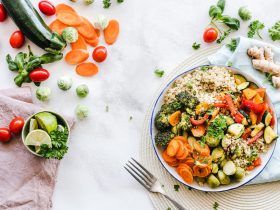The assumptions of the ketogenic diet can be summarized using the slogan “Eat fat and you will burn fat.” It is commonly used by people who want to get rid of extra pounds accompanied with weight training or physical activity, but it is also perfect for those who have diabetes or high blood pressure. This diet has a lot of supporters, but also a large group of opponents, who indicate that its use has many side effects. How is it really?
The ketogenic diet: rules
The ketogenic diet is an eating system based on the principle of increasing the supply of fat while limiting the number of consumed carbohydrates. However, it will be effective and safe for the body only if it is used under the supervision of both a doctor and a dietitian.
When following a ketogenic diet, you should consume the right amount of both fat, proteins and carbohydrates. For most of us who eat “normally” our meals are 50% carbohydrate, 15% protein, and 35% fat. In the case of a ketogenic diet, these proportions are completely different. Ketogenic diets are 70-75% of fat. The remaining 25 – 30% are carbohydrates and protein. For people who do not follow a ketogenic diet, carbohydrates are the primary source of energy. However, there are very few of them in the ketogenic diet. This means that the body must look for other sources. They become fats.
The consequence of this condition is also called ketosis. It is the breakdown of fats. As a result, there is a significant increase in the concentration of ketone bodies in the blood. It is much higher than the concentration of glucose. Sufficiently low amount of carbohydrates stops the feeling of hunger. However, if there are too many of them, it will reappear.
What are the benefits of the ketogenic diet?
Many people believe that the most important advantage of the ketogenic diet is the feeling of lightness, improved well-being, and an energy boost during the first two or three months of its use. The primary goal of the ketogenic diet is to get rid of extra pounds. It turns out that by following the rules, the weight starts to drop dynamically.
Glucose – since it is no longer the primary source of energy – can be used by the nervous system. There is a decrease in the amount of glycogen. Less glycogen translates to less water. It was the glycogen in the muscles that bound it. The consequence is weight loss.
The use of a ketogenic diet is also recommended for people suffering from epilepsy, especially for children with drug-resistant epilepsy. To date, it has not been possible to fully determine what causes the reduction in the frequency of epileptic seizures in people using the ketogenic diet.
It is believed to be related to the protection of nerve cells by ketone bodies.
It is also indicated that the ketogenic diet contributes to a more effective fight against insulin resistance. It regulates the secretion of insulin, reduces the appetite for sweets, and the feeling of fullness lasts much longer. The use of a ketogenic diet also means less swelling, as well as no digestive ailments, which include flatulence.
What are the disadvantages of the ketogenic diet?
The ketogenic diet – although very effective in the fight against extra kilos – should not be used by everyone. Possible side effects are the cause. The boost of energy, better well-being, and the feeling of lightness are temporary. After about three months, these effects lose. Instead, there are:
digestive system ailments
energy drop
fatigue
difficulty concentrating
constant desire for sweets
In addition, there is an unpleasant body odor that is harmful to the environment.
Too much fat in the diet can disrupt the intestinal function. There may be persistent and almost non-stop pains located in the lower abdomen. When this diet is used for a longer period, may appear increased uric acid levels.
This diet should never be used by people struggling with diseases:
kidney
pancreas
liver
It is also not recommended when the metabolism of ketone bodies is overloaded. Many specialists emphasize that the use of the keto diet negatively affects the body’s hormonal balance.
What is allowed to eat while on a ketogenic diet?
In the case of a ketogenic diet, it is of great importance not only to observe the correct proportions of proteins, fats, and carbohydrates, but also the type of consumed products. A certain amount of nutrients should be provided through wholesome and top-quality products. The main source of calories is fats. You should reach for those that are really good.
When choosing fats consumed during the diet, you should choose those that are as least processed as possible. Saturated fats are recommended, which include butter, coconut oil.
You can also reach for monounsaturated fats, the excellent sources of which are nuts, avocados and oil. Are polyunsaturated fats advisable? If they are animal fats consumed in the form of fatty fish, for example, they can be eaten. You should avoid those processed products.
When it comes to protein, meat is recommended on a ketogenic diet. Basically, the rule is simple: the more protein in meat, the less it should be introduced into the diet. The meat should be of good quality. The same is true for eggs.
Carbohydrates should be provided to the body through vegetables and fruits. The principle, however, is similar to that of meat, carbohydrates should be consumed less. You should reach for those vegetables that contain as little sugar as possible. Green ones that grow above the ground are especially recommended.
Contrary to what you might think, the list of products that you can reach for when following a ketogenic diet is really rich and preparing a variety of tasty meals is really possible.
When following a ketogenic diet, you can reach for:
Poultry, eggs – however, it is worth reaching for meat from organic farming.
Fish and seafood – when it comes to fish, salmon, sardines are especially recommended;
Fats such as butter, coconut oil, olive oil.
Vegetables – especially spinach, broccoli, lettuce, Brussels sprouts, avocado, cucumbers are recommended;
Dairy products – you can eat cream and full-fat milk.
Still water, tea (both black and green), coconut milk and almond milk.
You can season the dishes with basil, oregano, coriander, cinnamon, cumin, chili, thyme, rosemary, and parsley.
What is prohibited on this diet?
When setting your diet, remember that many foods on a ketogenic diet are prohibited. You should completely give up sugar. Sweets, sweetened juices and carbonated drinks are forbidden. You also need to exclude grains from your diet. Therefore, it is forbidden to eat breakfast cereals, pasta, rice, corn, all wheat products. Products containing starch should not be included in the menu. These are not only potatoes, but also bananas. When it comes to fruit, other than bananas, you shouldn’t eat grapes, pineapple, watermelon, apples and oranges. What you should forget about are the light products.
Endnote:
The ketogenic diet brings about rapid weight loss. However, it should be remembered that in the event of occurrence and persistence of such symptoms as drowsiness, constipation, and dizziness, discontinue the diet and consult a doctor.




































Leave a Reply